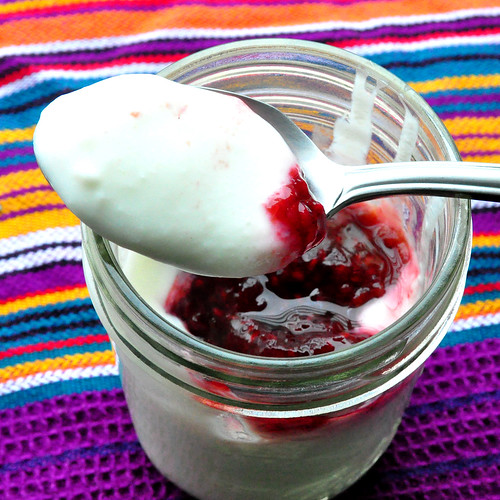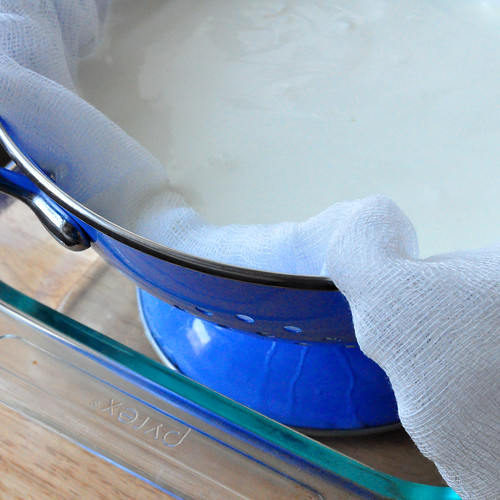I ran into an article at NY Times about this a while back and I finally worked up the nerve to try it myself. You can use any milk you like (obviously whole milk will produce a richer and tastier yogurt), but it's always been frustrating to me that Greek yogurt can only be bought in full fat or completely fat free (and weird tasting) versions. So I picked up 1% milk and a tiny tub of full fat greek yogurt to use as a "starter". It takes very little work, a bit of patience, a cheese cloth and some fridge space. I portioned the thickened deliciousness into a bunch of small jam jars, topped half of them with a spoonful of my raspberry jam and after a glamor shot or two tucked into the first one. Yum!

To make your own, pick out the milk you'd like to start with. Local, organic, or raw would no doubt give you amazing results, but even regular store bought stuff will work here. You can use as much, or as little as you like, but half the point is the value of doing this yourself, so start with a half gallon of milk, at least.
Heat the fresh milk at 180F to 190F degrees, or to the point that it’s steaming and beginning to form bubbles. I used my thermometer, watched the pot closely, and took it off heat exactly at 183F. The heat alters the milk’s whey proteins and helps create a finer, denser consistency. Don't overheat the milk or you'll start to alter the taste or it could boil up and run away.
Let the milk cool to around 115F to 120F degrees, somewhere between very warm and hot. For each quart of milk, stir in two tablespoons of yogurt, either store-bought or from your last batch, thinning it first with a little of the milk. So for your half gallon, a quarter cup of yogurt should do it.
They say to put the milk in a warm jar or container or an insulated bottle, cover it, and keep the milk still and warm until it sets, usually in about four hours. I don't like getting extra containers dirty, so I tightly wrapped the pot with three kitchen towels, stuffed it into the microwave and left it to "cure" overnight.

In the morning, the yogurt was nice and set, so I lined a colander with several layers of cheesecloth, set it over a pan to catch the whey, and dumped the yogurt in to drain while I was at work. You can see the whey and its lactic acid drain out in the picture above.
After several hours, scoop the thickened stuff into clean containers of your choice and enjoy. So far I've just been eating it straight, but I think it would be lovely in lots of recipes too.






0 comments:
Post a Comment